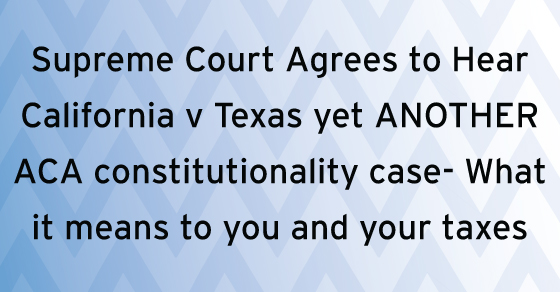Recently, the Supreme Court agreed to hear yet another lawsuit in a long line of lawsuits regarding the constitutionality of the Affordable Care Act.
The Texas case is rooted in Congress’ decision to repeal the individual mandate as it pertained to Americans to either obtain health insurance or pay higher taxes. The Tax Cuts and Jobs Act of 2017 reduced this penalty tax to zero. The argument in the Texas case is that since the constitutionality of the ACA was based on the ability of Congress to tax, if the tax is calculated to be zero when the individual mandate was repealed, then it really wasn’t a tax to begin with. How can something be a tax if it raises no money whatsoever? The argument is that zeroing out the assessment eliminated the taxing power justification for the “minimum coverage” requirement, that the entire ACA should be invalidated because that provision cannot be severed from the rest of the ACA.
What does this mean to you-
The ACA also included two new taxes to help fund the provisions of the ACA as follows:
Medicare Surtax on Wages- The ACA increased the Health Insurance (HI) tax payable by the employee by
.9%. The additional .9% applies to an individual’s taxable wages (and any self-employment income) in excess of $250,000 for a married taxpayer filing a joint return, $125,000 for married filing separately, and
$200,000 for all other filers.
Tax on Net Investment Income- The ACA also expanded the Medicare tax to certain individual’s Net Investment Income (NII). This 3.8% Medicare tax applies to the lesser of (1) and individual’s net investment income, or (2) the excess of the individual’s modified adjusted gross income (MAGI) over
$250,000 for a joint return, $125,000 for married filing separately and $200,000 for most other returns.
Many commentators and legal experts involved in ACA litigation, believe that it is highly unlikely that the Court will find the ACA unconstitutional. In the improbable event that the Supreme Court does find that the ACA is unconstitutional and that the taxes levied by it are also by definition unconstitutional, a refund opportunity for the above taxes paid would exist. However, a taxpayer will only be able to claim a refund for those taxes if the statute of limitations is open for a given tax year, or the limitations period has been tolled with the filing of a protective claim for refund.
The Supreme Court is not expected to rule on this case until after the 2020 elections and possibly not until 2021. If you paid these taxes on your 2016 or 2017 returns and want to preserve your right to a potential refund, you will need to file a protective claim for refund. If you want to file a protective claim and your 2016 return was filed prior to July 15, 2017 then the protective claim must be filed by July 15, 2020. For 2016 returns filed after July 15, 2017 the due date for the protective election is due three years from the date it was filed.
Click here for a protective claim template that you can complete and file to the address attached to the template. We strongly recommend that the claim be filed using certified mail return receipt requested when mailing your claim to provide evidence of timely filing. If you were subject to either tax, there is no harm in filing the protective claim and there is no downside in doing so. The claim is straightforward and is easy to complete should you decide to do so. If you do complete and file, you are only out a few minutes of time and the mailing costs. It is that simple.
If you have any questions concerning your decision to file a protective claim, please contact your Maillie representative via phone or email.





